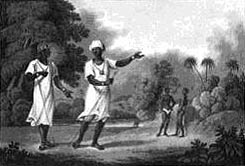“A contracted system of agriculture, conducted by their women and slaves, in a very few days prepares the lugars, or cultivated fields; and the harvest is distributed by the elders of the community, according to the portion and wants of the society of the village, or is stored up to be portioned out as circumstances may require…
Esculent vegetables are various: Rice, which forms the chief part of the African’s sustenance. The rice-fields or lugars are prepared during the dry season, and the seed is sown in the tornado season, requiring about four or five months growth to bring it to perfection… Yams, a nutritious substance, known in the West Indies… Cassada or cassava, a root, of a pleasant taste when roasted or boiled, and makes an excellent cake, superior in whiteness to flour. Papaw, of a deep green in its growth, but yellqw when ripe, and is an excellent dish when boiled; its leaves are frequently used by the natives for soap; ropes are made of the bark.
Oranges and limes are in great abundance, and of superior quality, throughout the year; but lemons degenerate much in their growth, and in a few years are scarcely to be distinguished from the latter. Guavas, pumpkins, or pumpions, squash water mellons, musk mellons, and cucumbers, grow in the greatest perfection. The pumpkins grow in wild exuberance throughout the year, and make a good pudding or pie.
Indian corn, or maize, may be reaped several times throughout the year, only requiring about three months growth…Millet, with a multiplicity too tedious to enumerate.
Sugar canes are not very abundant, but are of a good quality, which, under careful management and industry, would, no doubt, yield productive returns… Coffee trees, of different nondescript species, only requiring the same interference.
Dyes, of infinite variety and superior texture: yellow is procured from the butter and tallow tree, producing a juice resembling gamboge, but more cohesive, and of a darker colour; the wood of this tree is firm, and adapted to a variety of purposes; its fruit is about the size of a tennis ball, nearly oval, thick in the rind, and of a pleasant acid taste, containing several seeds about the size of a walnut, and yielding a viscous substance used by the natives in their food. Red and black are procured from a variety of other trees and plants; and indigo growing in wild exuberance, particularly in the rivers more to the northward.
Cotton, in great varieties, requiring only cultivation to raise it to perfection and amount. The natives manufacture from it a narrow cloth, which is made from thread, spun in a manner similar to the distaff (Corry 1807).


